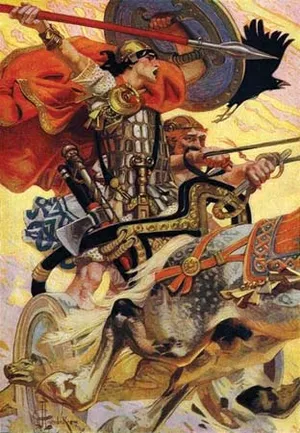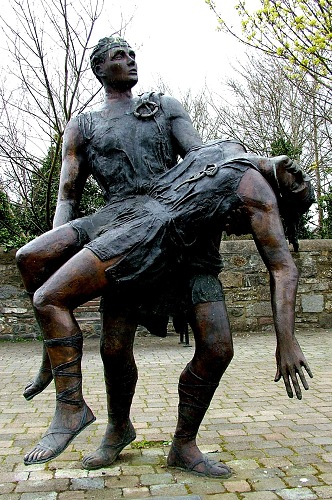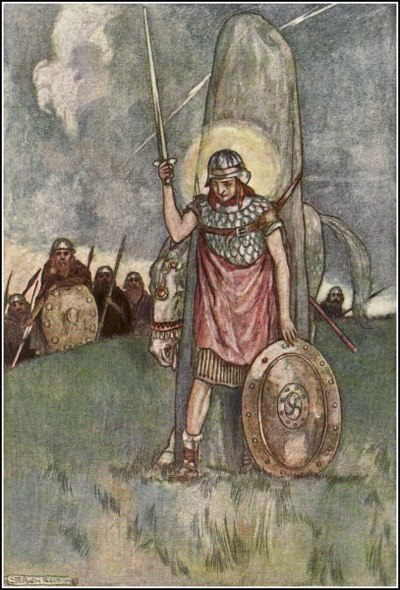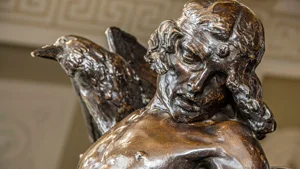The history of the divergent Celtic people is interwoven with their folklore and legends, going back to a time long before Christian arrived and began to transcribe their tales. It can be difficult to speak briefly on this subject, as many of these tales are epics equal to that of the Mesopotamian Gilgamesh or Greek mythologies Odysseus. These stories inspired the people of their time, helping to create a vast cultural tapestry of oral traditions and early education that bound the different Celtic nations together. As we count down the days before Celtic Fest Ohio 2023, join me as we talk about the most famous hero in Ireland.
Cuchulain (koo-KUL-in)
The Ulster Cycle, 1st Century Ireland
Transcribed, 12th Century Ireland
Conception & Birth
Cuchulainn could easily be described as a demigod, born from the mortal princess Deichtire and Lugh, one of the Tuatha de Danann, a tribe of ancient supernatural beings, near god-like in their capabilities. Deichtire was the sister to Conchobar mac Nessa, the king of Ulster, and often accompanied him on hunts to drive his chariot. During the hunt, a snowstorm began, and the party was forced to take shelter in a local house. During the night, the wife of their host goes into labor at the same time as a mare in the stables. Deichtire acted as midwife, but when the sun rose in the morning everything was gone. Lugh appeared and told Deichtire that he had lain with her the night before and given her a child. Horrified at the scandal, as she was soon to be married, Deichtire tried to abort the fetus. Believing herself successful, she went to her husband on their wedding night and conceived a child, which they named Setanta.
But like most Irish myths, the folk of the Tuatha de Danann are more cunning than mortals.
Childhood
As a child, Setanta was eager to join the boy-troops of Emain Macha, the site of his uncle Conchobar’s fort in what is now County Meath, Ireland. The troops were a group of young, rowdy boys who were likely the sons of nobles and other warriors. When he arrived and saw the other boys playing in the field, Setanta was so excited to join them that he overlooked certain traditional manners and did not ask to be put under their protection first. The youths took this as a challenge from a newcomer and set on him in unison. Setanta, much to their surprise, went into a berserker rage, defeating them easily. His uncle, the king, arrived and put a stop to the mischief. But his nephew refused to relent until the rest of the boys put themselves readily under his protection since they clearly could not protect themselves.

In another of the fantastical tales of his younger years, Setanta was traveling to visit his uncle while they stayed with a smith named Culann. When Culann asked Conchobar if all of his entourage had arrived, he forgot that his nephew was on the way and told their host that all was well. Culann, therefore, set his ferocious hound at the door to guard his home against any intruders. When young Setanta arrives, the hound set itself upon him, determined to tear the child to shreds. When the king and his guests heard the commotion, Conchobar remembered his nephew and they all arrived to find Satanta, covered in blood but unharmed, and the dog dead. Culann, understandably grieving the loss of his hound, is furious, and Setanta felt ashamed to have cost the man his grand protector. So in an act of redress, he swore to raise a new hound for Culann to have, and until it was old enough he would guard the smith’s house as a replacement. For this, his uncle takes to calling the boy Cuchulainn, or ‘hound of Culann’, as an affectionate term for his fair-minded but unflinching nephew.
In some stories of the famous hero, Cuchulainn is prophesized by a druid (in some instances his own grandfather on his mother’s side, Cathbad), to live a tragically short, but glorious life in which his fame would never die. Encouraged by this portend, Cuchulainn sets out with the same thoughts of most young men who can only live in the now because the future is too far away to be seen. He trained in Scotland (possibly the Isle of Skye) by the side of a mythical warrior woman named Scathach who is so impressed with the young man that after a year of training, she gifts him her gae bulga, a barbed spear with brutal results on its victims. Cuchulainn becomes dear friends with a fellow trainee named Ferdiad, the only other who rivals his capabilities. Through their rivalry, they dedicate themselves as foster brothers, and in many tales, they were said to share a bed and spoke often of their great love for one another.
Upon his return, Cuchulainn’s great deeds continued to grow, but the most oft-repeated tale is that of the Cualnge Cattle-Raid.
Tain Bo Cualnge (The Cualnge Cattle-Raid)

The men of Ulster suffered under a strange curse that caused them to experience incredible pain as though they were in the middle of giving birth whenever the kingdom was in danger. As such, they are struck down by this malady as Queen Medb of Connacht invades Ulster lands to steal the Donn Culailinge, a brown bull so powerful and magnificent that she had to add it to her wealth. By fate or by loop-hole, Cuchulain was the only one young enough (at seventeen) to not be considered a man during the invasion, as so was not subject to the effects of the curse. So, it fell to him to defend the kingdom from the raiding army with none but his charioteer to assist him.
Time and time again, Cuchulainn defends Ulster at each opportunity, invoking the right of single combat whenever Queen Medb’s army tries to cross a ford. Each time Medb sends one of her champions to defeat the young warrior, she can do nothing but watch as they are slaughtered either through Cuchulainn’s superior might or the riastrad, the berserker-like rage he is capable of. Between each bout he is tested, or, given her nature, possibly flirted with, by the Morrigan, the Tuatha de Danann of war and fate. Each time he refuses and defeats her, the Morrigan distracts him during his battles. When he defeats his enemies nonetheless, she appears to him as an old woman, giving him three sips of her milk. As he blesses her kindness, the wounds he gave her heal and she relents her torment.
During another battle between champions, Cuchulainn is grievously injured and thinks he may die. While he waits, Lugh appears to him, claiming to be his father and in a show of pride for his offspring, heals Cuchulainn’s wounds and brings about the riastrad. Cuchulainn attacks the army with unfettered rage and slaughters hundreds, erecting a wall of corpses to defend Ulster. One by one he defeats other great warriors such as Loch mac Mofemis, Fergus mac Roich (in some telling his own foster father), and finally Ferdiad, his best friend and possible romantic partner.

“Dear to me thy noble blush;
– Cuchuliann to Ferdiad, Tain Bo Cualnge
Dear thy comely, perfect form;
Dear thine eye, blue-grey and clear;
Dear thy wisdom and thy speech!”
Though in the end, he is unable to prevent Medb from stealing the bull, Cuchulain ensured that the price for its theft was dear indeed. Eventually, the Ulstermen recover from their labors and rise to join him on the field of battle. They corner Medb, but Cuchulainn shows mercy as he does not believe it is right to offer harm to a woman. She takes the bull and retreats back to Connacht, and it is a long time before the Queen seeks to harass Ulster’s champion again.
Death
Even the greatest heroes cannot avoid their fate. It would be easy to say that Cuchulainn never attempted to avoid his death, but seemed determined to hurry it along! What I have provided here is a limited example of the dozens of tales surrounding Cuchulainn, yet it would be belittling to talk about the life of Ireland’s greatest folklore hero without discussing his death.
One does not become a famous warrior without making a few enemies along the way. So it was that when Queen Madb decided to seek her revenge against the Ulster hero, she enlisted the help of the sons of men that Cuchulainn had killed. They came up with a plan to force the hero to break his geas, a powerful prohibition or obligation set on a person, and therefore cause his downfall. While he traveled, Cuchulainn is offered hospitality by an old crone, who presents him with dog meat as his meal. Given his history with hounds, the hero has a geas on him that forbids him to eat dog meat. Moreover, the people of ancient Ireland had a strong cultural prohibition against refusing hospitality. In this way, they forced him to violate both. To ensure his death, Lugaid mac Con Roi has three magical spears forced, and it is said that a king will die when each is thrown.

When it comes time to do battle, Lugaid throws the first spear and kills Laeg, Cuchulainn’s friend and the ‘king’ of charioteers. The second strikes one of Cuchulainn’s horses Liath Macha, the ‘king’ of horses. With the final spear, he takes aim and strikes the great hero himself, delivering a lethal blow. With the last of his willpower, Cuchulainn drags himself to a standing stone and ties himself to it so he will die on his feet with his sword in his hand. His enemies, still terrified of his reputation, hesitate to approach until a raven lands on his shoulder. Assuming this means he is dead, Lugaid goes to make sure. In one final act of determination, Cuchulainn’s sword arm falls, cutting off the hand of his killer. It is only when the others cut off the hero’s sword arm that he finally passes, having no more means by which to defend his homeland.
The stone to which Cuchulainn is said to have bound himself is Clochafarmore, a standing stone in Knockbridge, Dundalk, County Louth, Ireland.
